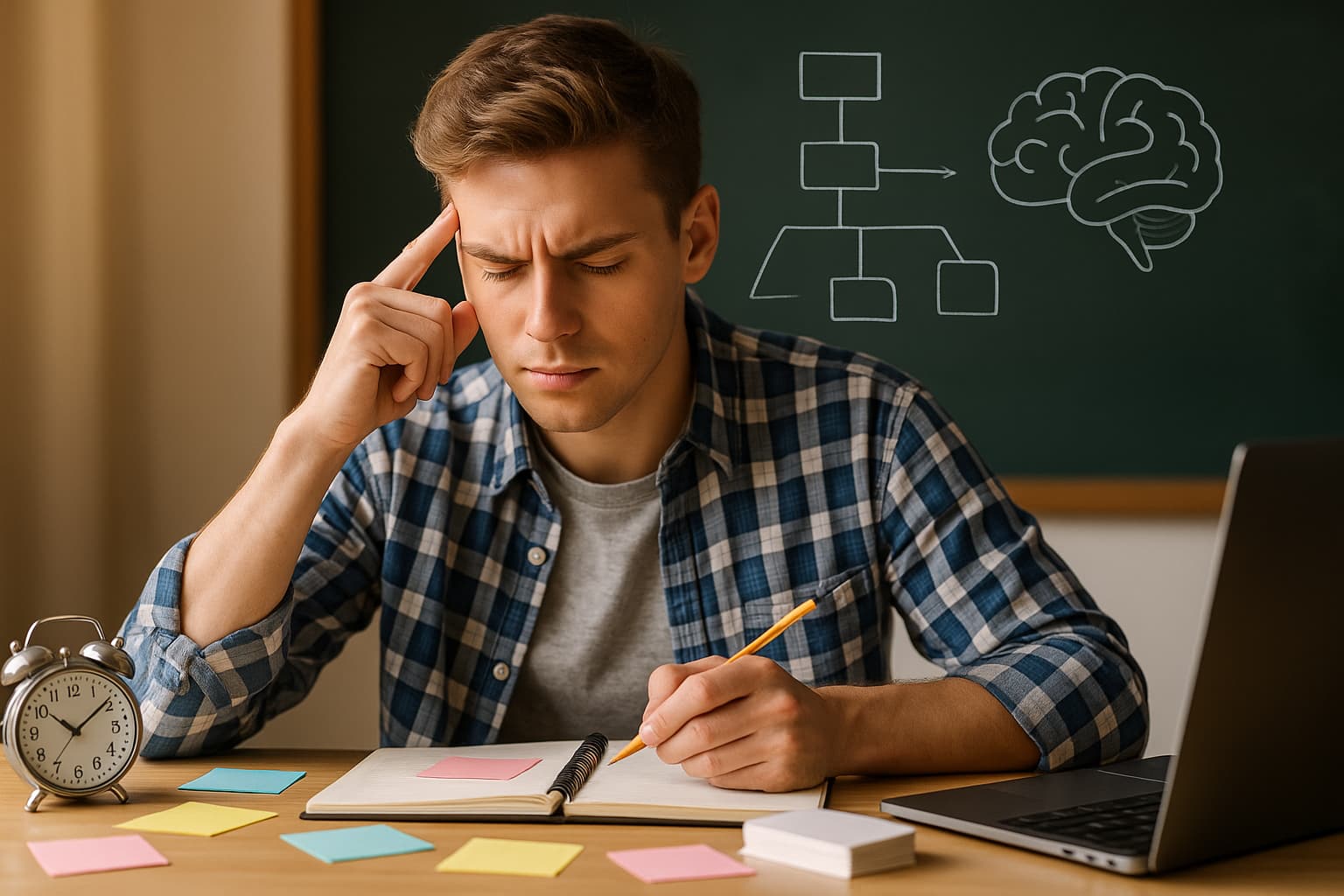 Freelancer tips
Freelancer tips How to Open an LLC from Mexico and Invoice in U.S. Dollars
Want to open a U.S. LLC from Mexico? This guide covers the basic steps to make it simple and hassle-free.



To memorize is the mental process of recording, retaining, and recalling data or experiences. It’s a key skill for both learning and productivity, as it helps solve problems and maintain concentration.
However, each person processes and remembers information differently. Some need more time to achieve long-lasting retention.
The good news is that today you can apply modern memorization techniques. These combine scientific principles about how the mind works with practical habits that strengthen attention, organization, and consistency. In this way, it becomes an essential tool for learning better and working more efficiently.
In this post we explain what those memorization techniques are, as well as strategies and factors that influence this process.
Memorization is the mental ability we have to store and retrieve data or experiences. It’s an essential brain function that helps us organize ideas, learn, and adapt to our environment.
To do so, the brain relies on three factors:
Attention, to filter what’s important.
Repetition, to consolidate what’s been learned.
Emotion, to link it to a personal meaning that makes it easier to remember.
But not all the information we retain is stored in the same way…
It first passes through short-term memory, where it’s kept temporarily (seconds or minutes). Then it’s transferred to long-term memory, which allows us to remember data, experiences, or learning even after a long time.
Memorization is a skill not everyone has naturally, but it can be trained and improved with practice.
Some effective memorization techniques are:
Spaced repetition.
Visual or auditory associations.
Method of loci (memory palace).
Self-assessment or active practice.
It’s based on the theory of the forgetting curve, which seeks to strengthen memory and improve retention. The idea is to study the same information at different times, increasing the intervals between reviews.
For example, review your notes one day after studying them, then three days later, and finally after a week.
They’re based on connecting data with images or sounds that trigger memory.
For example, associating the name of a new client with a color, a logo, or a characteristic phrase of their brand.
The more senses involved, the easier it will be to remember what you learned.
These are graphic organizers useful for summarizing, studying, or planning, as they make it easier to grasp the overall content in a visual format.
For example, you can create a mind map to review a topic using keywords and colors that help you recall faster.
It reinforces recall through tests or exercises that force the brain to retrieve information, improving retention with each attempt.
For example, try explaining a topic after reading it, without looking at your notes.
It allows you to associate concepts with imaginary places, leveraging spatial memory to remember sequences or lists.
For example, visualize a mental route where each key point of a presentation is placed in a different spot.
These aren’t the only valid and effective methods, but they’re among the best-known. Integrating them into your study or work routine will let you make better use of what you learn each day.
Memorization is essential for both learning and professional performance. That’s why you should choose suitable strategies that facilitate concentration, information organization, and constant review.
Some memorization strategies are:
Short, focused sessions. Study in blocks of 25 to 40 minutes to maintain attention and avoid mental fatigue.
Visual tools. Creating a mind map, concept map, or summary chart will help stimulate visual memory and make it easier to recall complex structures.
Connection with prior experiences. Associating new concepts with familiar situations or everyday examples can be useful for improving understanding and recall.
Digital support. Online resources are key allies for studying and working remotely. Some remote-work tools help organize information or save review materials.
Memorization can be applied in different contexts. For example, to recall relevant concepts on an exam or to reinforce confidence and fluency when speaking in work presentations.
How to improve memory?
Applying memorization techniques and strategies isn’t enough. Certain factors directly influence your ability to remember data, such as:
Adequate rest. Sleeping well supports memory consolidation. During sleep, the brain organizes and reinforces the information learned during the day.
Balanced diet. A diet rich in omega-3s, fruits, vegetables, and proper hydration improves cognitive function and concentration.
Attention and focus. Keeping your mind focused improves the quality of learning and helps avoid rote learning. Practicing Deep Work is a way to assimilate information more clearly and effectively.
Understanding before memorizing. When you understand the content, it’s easier to connect ideas and improve retention.
Repetition and teaching. Reviewing frequently or explaining the topic to someone else can help reinforce memory and detect possible gaps in understanding.
Together, these factors enhance the effect of any memorization technique and encourage more solid, long-lasting learning.
The first thing to know is that there’s no single technique that works the same for everyone. Habits are key to building a system that fits your way of learning and your goals, whether personal or work-related.
With that in mind, we suggest:
Use multiple techniques. You can apply different methods depending on the content type. For example, mind maps for complex ideas, spaced repetition for data or dates, or visual associations for names.
Turn review into a habit. Create a schedule with your study sessions or spaced-repetition practice to distribute topics evenly. Tools like Google Calendar help you schedule reviews, receive reminders, and visualize your progress.
Leverage digital and visual resources. If you learn better with images or videos, use apps like CapCut to create or consume audiovisual content.
Evaluate your progress. Conduct periodic reviews to identify what you remember and what still challenges you—that’s part of learning.
A memorization system can be adjusted to your pace and style. The important thing is to keep in mind that it’s not just about remembering more, but about learning better.
Memorization helps us recall daily facts and complex concepts learned over time. However, each person experiences it differently, depending on attention level, habits, and how information is processed.
That’s why memory methods are used—because not everyone retains the same way. Some do better through images, others through repeated practice, or with audio support.
The key is to identify which memorization technique works best for you and apply it consistently. Over time, it will stop feeling like an effort and become a trained skill that boosts learning and understanding.
The more we exercise memory, the stronger it becomes.
If, in addition to keeping your ideas fresh in your memory, you want to organize your finances, use DolarApp. You’ll be able to manage digital dollar or euro accounts to receive/send payments abroad and buy/sell at a fair exchange rate.
There are various methods to remember information, though not all work the same for everyone. However, spaced repetition, mind maps, and the method of loci are among the most used and effective.
Memorization allows you to retain information, while understanding implies interpreting it, relating it, and giving it meaning. The latter supports deeper, longer-lasting learning.
Study the same information several times, leaving more time between each review. This way, you train your memory and help it retain knowledge longer.
Some habits include sleeping well, maintaining a balanced diet, and practicing deep concentration. Regular exercise, frequent reading, and avoiding digital distractions during study sessions also help.
Sources:

Os países têm fronteiras. Suas finanças, não mais.
 Freelancer tips
Freelancer tips Want to open a U.S. LLC from Mexico? This guide covers the basic steps to make it simple and hassle-free.

 Freelancer tips
Freelancer tips Precisa comprovar seus ganhos, mas não sabe por onde começar? Neste artigo, explicamos como obter um comprovante de renda em PDF.

 Freelancer tips
Freelancer tips Management by Objectives (MBO) improves focus and each person’s role within the organization. Discover how to apply it in your business.


